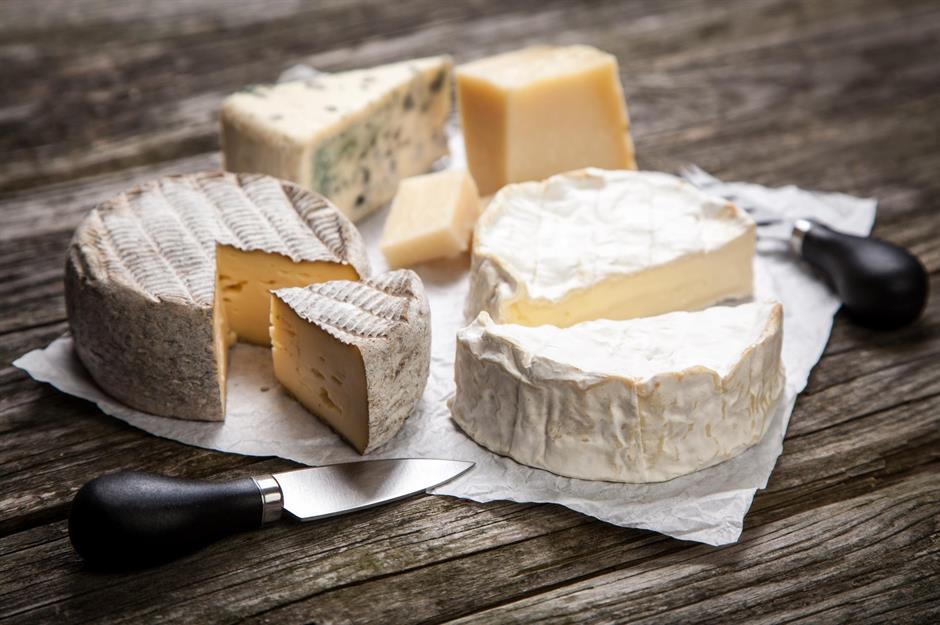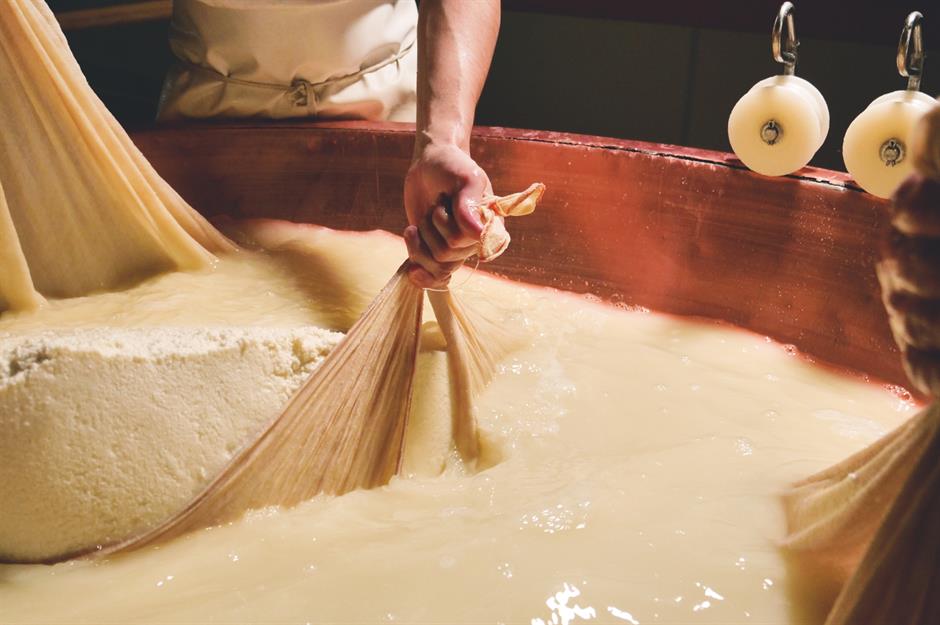Everything you wanted to know about cheese
Say cheese
How cheese is made
Cheese begins with heated milk, to which a starter culture is added, which converts the lactose sugars to lactic acid, and prevents any bacterial growth. Then rennet, an enzyme, goes in, which curdles the milk and makes the proteins coagulate to create a solid mass. The solid cheese is cut into curds, drained from the whey, then salt is added and the process begins – cutting, draining, pressing and ageing.
Cows' milk cheeses
Cheeses made from cows' milk are the most common across the world, because cows produce a lot of milk and it's the most versatile to make cheese. If the cow is grass-reared, the colour of the cheese will be a rich, golden yellow, from the high amount of beta carotene (an orange plant pigment) in the feed, which increases the butterfat content of the milk.
Goats' milk cheeses
Goats' milk cheeses are always pure white, because goats absorb the beta carotene from their feed or grass which is converted to vitamin A, and the milk is therefore white. Cows don't absorb it, so it passes into their milk, hence the milk is a different colour. Goats' cheese is lower in fat and is tangy with flavours of citrus when young, which ages into more farmyard, earthy aromas and flavours.
Sheep's milk cheeses
Sheep's milk cheeses tend to be on the more artisanal, expensive end of cheese, simply because rearing them for milk is more time-intensive than cows or goats. The milk is in between cows' milk and goats' milk – a soft, ivory colour. It's quite high in fat, with smooth, nutty flavours which develop as the cheeses age.
Buying cheese
Get to know your cheesemonger as well as your butcher. With the steady rise in artisanal cheese-making, there's a better chance of discovering new cheeses from small producers. Equally, many cheese shops sell online, giving an excellent choice of quality cheeses.
Love this? Follow our Pinterest page for more food inspiration
Pasteurised versus unpasteurised
In the US, making cheese from unpasteurised or raw milk is prohibited. But not across Europe and UK, where many famous cheeses are unpasteurised, following strict rules from their controlled designation of origin. Gruyère, Comté and Camembert AOC are such examples. Some makers say there is more expression from the unpasteurised milk in the cheese, but just because a cheese is unpasteurised, it's not necessarily better. It's all down to the cheesemaker.
The cheese family: fresh cheeses
These are young, reasonably soft cheeses, with no rind on the outside, so they have a shorter shelf life. The fresher the cheese, the faster you should consume it. They are mild-tasting, with good acidity and often a citrus tang. Cheeses in this category include buffalo mozzarella, feta and fresh goats' cheese.
The cheese family: bloomy rind cheeses
These cheeses are white, creamy and soft. They are inoculated with a white mould, after which they are dried and left to age, which encourages the white mould to grow and encapsulate the cheese. The most famous examples are Brie and Camembert. English Tunworth cheese, similar to Camembert, is also definitely worth a try.
The cheese family: washed rind cheeses
Made in a similar way to bloomy rind cheeses, these are usually soft (with a few exceptions, such as raclette). Rather than allowing the white mould to grow, they are washed frequently to encourage growth of an orange bacteria. This gives a rich, savoury flavour. These cheeses often smell stronger than they taste, like Epoisses. Other examples are Taleggio, Vacherin Mont d'Or and Munster.
The cheese family: semi-hard cheeses
These fall into two camps: hard pressed, the classic British way in which Cheddar is made, where moisture is driven out of the cheese by acidifying it, then stacking and pressing it; and hard heated, more common in mountain cheeses from France and Switzerland, where the curds are cut very small to draw out the moisture then are heated, producing a sweeter flavour, such as Gruyère or Comté. Cheeses made from summer milk will be more herbaceous than from winter milk.
The cheese family: hard or grainy cheeses
The home of these rich, savoury cheeses is Italy, the most well known being Parmesan, pecorino and Grana Padano. The curds are cut with a huge whisk, so they end up being as small as a grain of rice. Once pressed into moulds or wheels, the cheese is soaked in a brine solution for up to 30 days. After drying, they are aged for at least nine months, but you can find them at 30 months or even longer.
The cheese family: blue cheeses
These cheeses are usually soft or semi-soft. The addition of blue mould – in the past natural moulds occurred in the air, often in caves, but now artificial strains are added manually – causes blue veins to form where the cheese is in contact with the air. Often, the cheese is pierced to allow the air in. The most famous blues are Stilton, Gorgonzola and Roquefort.
Storing soft cheeses
With Camembert-style and Brie cheeses, the waxed paper they come in is the best wrapping for the cheese. If there's no waxed paper, use cling film and wrap tightly, ensuring no air can get in.
Storing blue cheeses
Wrap all blue cheeses in cling film, then place in an airtight container. This will give the cheese more longevity, as no air can get to it, and will stop any further blue veins developing.
Storing hard cheeses
There's very little moisture in hard cheeses, so they have a much longer shelf life. Simply wrap in cling film to keep the air out. If any patches of green mould appear or if the cheese becomes hard in certain areas, just scrape off the mould and cut out the hard sections.
Serving cheese
Cheese should always be served at the correct temperature. Soft cheeses should be at room temperature. If you've bought one with any chalkiness through the centre, leave it out of the fridge for three to four hours to ripen further. Take blue and hard cheeses out of the fridge 20 minutes before serving, just to take any chill off them and to release the full flavour.
How do I know it's ripe?
This applies specifically to bloomy and washed rind cheeses. If you buy from a good cheesemonger, tell them when you want to serve it and they should sell you the perfect cheese. Sell-by dates, although demanded by law, aren't the best indicator where ripeness is concerned. If you gently push the cheese with your fingers, it should feel soft. You could also leave the cheese out of the fridge for a few hours to make it ripen further.
Age matters
Should I eat the rind?
The answer is a definite yes! Where soft bloomy and washed rind cheeses are concerned, the outer rind is part of the cheese, adding texture and flavour. Even with goats' cheeses coated in ash, there's absolutely no harm in eating the whole thing. The rind on semi-hard and hard cheeses is harmless too, but it's probably too hard to actually eat.
Save the rind on grainy cheeses
Even though you probably don't want to eat it straight up, don't ditch the hard rind from Parmesan or pecorino. It's used traditionally to add an extra savoury flavour to a meat ragù or soup. You could also add it to the stock when making risotto or try popping it into any slow-cooked meat or poultry stew.
Lactose-intolerance and cheese
Freezing cheese
Semi-hard and grainy cheeses all freeze well. In fact, any cheese you can grate easily can go into the freezer. The freezing process dulls the flavour, so frozen cheese can't be destined for a cheeseboard, but it's perfectly fine for using up in cooking.
Take a look at these genius recipes made from freezer staples
How to build the perfect cheeseboard
A stunning cheeseboard makes the perfect finale to a great meal, especially during the holiday season. Aim for three or four cheeses – any more gets too much for the palate. Aim for different styles and textures: a hard cheese like mature Cheddar, a soft washed or bloomy rind cheese such as Brie or Epoisses, and a blue cheese such as a traditional English Stilton would be a great combination.
One knife per cheese
Vegan cheese
With the rise in plant-based eating, vegan cheese is having a moment. Of course, it's not really cheese per se, as there's no milk, but it does offer an alternative to the real thing. They are based on plants such as nuts, coconut, soya and vegetables. Opt for those which are as little processed as possible, or make your own ricotta-style vegan cheese at home, using our recipe based on cashew nuts.
The best cheese for macaroni cheese
A great mac 'n' cheese is all about the cheese, so it needs something strong which really sings out – a mature Cheddar is always a favourite. But try mixing it with a different tasting, good melting cheese such as Gruyère, which is nutty and slightly sweet. Sprinkling grated Parmesan over the top adds a deeper, more savoury taste.
The best cheese for a burger
For a cheeseburger, the cheese needs to be uniform in thickness and to melt well – but not so much as to melt all down the side, making it impossible to eat. It's why processed cheese slices are commonly used, but not everyone's a fan, with the added vegetable oils and emulsifiers. Pre-sliced Cheddar, Monterey Jack and Emmental will do the job perfectly.
The best cheese for a toastie
Oozing, melting and always irresistible, a mature Cheddar is the first choice for a toastie. The important part is to grate it, because the small pieces of cheese melt uniformly. You can mix any strong-flavoured cheeses which grate well, or try our toastie recipe with a hint of chilli and small pieces of mozzarella.

